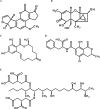Prevalence and effects of mycotoxins on poultry health and performance, and recent development in mycotoxin counteracting strategies
- PMID: 25840963
- PMCID: PMC4988553
- DOI: 10.3382/ps/pev075
Prevalence and effects of mycotoxins on poultry health and performance, and recent development in mycotoxin counteracting strategies
Abstract
Extensive research over the last couple of decades has made it obvious that mycotoxins are commonly prevalent in majority of feed ingredients. A worldwide mycotoxin survey in 2013 revealed 81% of around 3,000 grain and feed samples analyzed had at least 1 mycotoxin, which was higher than the 10-year average (from 2004 to 2013) of 76% in a total of 25,944 samples. The considerable increase in the number of positive samples in 2013 may be due to the improvements in detection methods and their sensitivity. The recently developed liquid chromatography coupled to (tandem) mass spectrometry allows the inclusion of a high number of analytes and is the most selective, sensitive, and accurate of all the mycotoxin analytical methods. Mycotoxins can affect the animals either individually or additively in the presence of more than 1 mycotoxin, and may affect various organs such as gastrointestinal tract, liver, and immune system, essentially resulting in reduced productivity of the birds and mortality in extreme cases. While the use of mycotoxin binding agents has been a commonly used counteracting strategy, considering the great diversity in the chemical structures of mycotoxins, it is very obvious that there is no single method that can be used to deactivate mycotoxins in feed. Therefore, different strategies have to be combined in order to specifically target individual mycotoxins without impacting the quality of feed. Enzymatic or microbial detoxification, referred to as "biotransformation" or "biodetoxification," utilizes microorganisms or purified enzymes thereof to catabolize the entire mycotoxin or transform or cleave it to less or non-toxic compounds. However, the awareness on the prevalence of mycotoxins, available modern techniques to analyze them, the effects of mycotoxicoses, and the recent developments in the ways to safely eliminate the mycotoxins from the feed are very minimal among the producers. This symposium review paper comprehensively discusses the above mentioned aspects.
Keywords: analysis; detoxification; gut; immune function; mycotoxicosis; occurrence.
© The Author 2015. Published by Oxford University Press on behalf of Poultry Science Association.
Figures



Similar articles
-
The role of bentonite binders in single or concomitant mycotoxin contamination of chicken diets.Br Poult Sci. 2016 Aug;57(4):551-8. doi: 10.1080/00071668.2016.1187712. Epub 2016 Aug 2. Br Poult Sci. 2016. PMID: 27172005
-
Review of mycotoxin reduction in food and feed: from prevention in the field to detoxification by adsorption or transformation.Food Addit Contam Part A Chem Anal Control Expo Risk Assess. 2011 Nov;28(11):1590-609. doi: 10.1080/19440049.2011.595377. Epub 2011 Jul 20. Food Addit Contam Part A Chem Anal Control Expo Risk Assess. 2011. PMID: 21770849 Review.
-
Potential application of probiotics in mycotoxicosis reduction in mammals and poultry.Crit Rev Toxicol. 2022 Oct;52(9):731-741. doi: 10.1080/10408444.2023.2168176. Epub 2023 Feb 9. Crit Rev Toxicol. 2022. PMID: 36757083 Review.
-
Mycotoxin toxicity and residue in animal products: Prevalence, consumer exposure and reduction strategies - A review.Toxicon. 2020 Apr 15;177:96-108. doi: 10.1016/j.toxicon.2020.01.007. Epub 2020 Jan 20. Toxicon. 2020. PMID: 31972175 Review.
-
Current Review of Mycotoxin Biodegradation and Bioadsorption: Microorganisms, Mechanisms, and Main Important Applications.Toxins (Basel). 2022 Oct 25;14(11):729. doi: 10.3390/toxins14110729. Toxins (Basel). 2022. PMID: 36355979 Free PMC article. Review.
Cited by
-
Physical and Chemical Methods for Reduction in Aflatoxin Content of Feed and Food.Toxins (Basel). 2021 Mar 12;13(3):204. doi: 10.3390/toxins13030204. Toxins (Basel). 2021. PMID: 33808964 Free PMC article. Review.
-
Deepoxy-deoxynivalenol (DOM-1), a derivate of deoxynivalenol (DON), exhibits less toxicity on intestinal barrier function, Campylobacter jejuni colonization and translocation in broiler chickens.Gut Pathog. 2021 Jul 3;13(1):44. doi: 10.1186/s13099-021-00440-6. Gut Pathog. 2021. PMID: 34217373 Free PMC article.
-
Mycotoxins in Poultry Feed and Feed Ingredients from Sub-Saharan Africa and Their Impact on the Production of Broiler and Layer Chickens: A Review.Toxins (Basel). 2021 Sep 8;13(9):633. doi: 10.3390/toxins13090633. Toxins (Basel). 2021. PMID: 34564637 Free PMC article. Review.
-
Mycotoxins in Broiler Production: Impacts on Growth, Immunity, Vaccine Efficacy, and Food Safety.Toxins (Basel). 2025 May 22;17(6):261. doi: 10.3390/toxins17060261. Toxins (Basel). 2025. PMID: 40559839 Free PMC article. Review.
-
Biomarkers of Deoxynivalenol Toxicity in Chickens with Special Emphasis on Metabolic and Welfare Parameters.Toxins (Basel). 2021 Mar 17;13(3):217. doi: 10.3390/toxins13030217. Toxins (Basel). 2021. PMID: 33803037 Free PMC article. Review.
References
-
- Agence Française de Sécurité Sanitaire des Aliments. Maisons-Alfort, France: Published by AFSSA; 2009. Évaluation des risques liés à la presence de mycotoxines dans les chaînes alimentaires humaine et animale; Agence Française de Sécurité Sanitaire des Aliments; pp. 1–308. Maisons-Alfort, France.
-
- Applegate T. J., Schatzmayr G., Pricket K., Troche C., Jiang Z. Effect of aflatoxin culture on intestinal function and nutrient loss in laying hens. Poult. Sci. 2009;88:1235–1241. - PubMed
-
- Avantaggiato G., Havenaar R., Visconti A. Assessment of the multi-mycotoxin-binding efficacy of a carbon/aluminosilicate-based product in an in vitro gastrointestinal model. J. Agric. Food Chem. 2007;55:4810–4819. - PubMed
-
- Awad W. A., Bohm J., Razzazi-Fazeli E., Hulan H. W., Zentek J. Effects of deoxynivalenol on general performance and electrophysiological properties of intestinal mucosa of broiler chickens. Poult. Sci. 2004;83:1964–1972. - PubMed
Publication types
MeSH terms
Substances
LinkOut - more resources
Full Text Sources
Other Literature Sources

